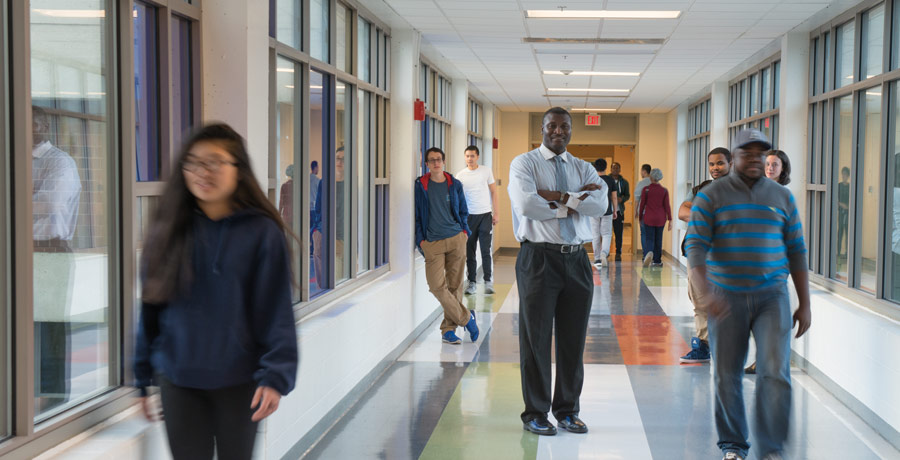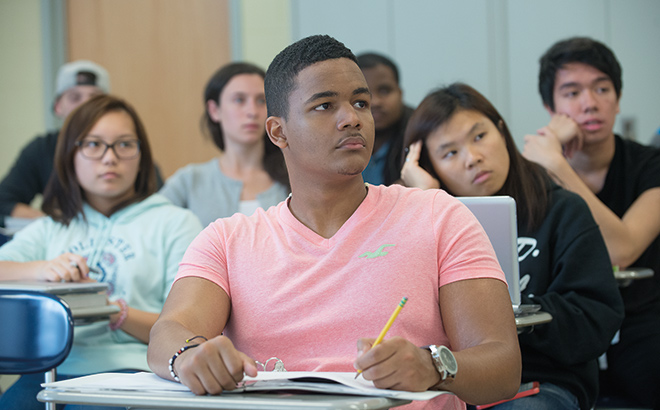
FAST TRACK TO COLLEGE
High school students discover an exciting route to the future
Fast Track to College
More than 550 high school students in Greater Boston take college courses in the evening through Bunker Hill Community College’s dual enrollment program. Now, in a new development, BHCC is offering “early college high school,” an outgrowth of dual enrollment that may be the education model for the future, when the boundaries of education expand from the traditional kindergarten-12th grade (K-12) to K-14, or even K-16. BHCC has just completed an early college pilot program at Malden High School, one of more than 30 high schools in the area where BHCC offers dual enrollment to high school students. College courses in high school? Here’s what that looks like.
It’s six o’clock on an autumn evening in Malden, a community north of Boston with a long history as a gateway city for immigrants. More than a third of today’s Malden residents were born outside the United States. In front of Malden High School, a few students wait for late rides home. With an enrollment topping 1,800, the school is a big place, occupying a full city block. At this hour, its long corridors are quiet and the classrooms are dim—with a few exceptions. A string of classrooms on an upper floor are brightly lighted. In one of them a lively discussion about major business news is under way. Russia’s declining economy. Apple’s latest iPhone. Currency manipulation in China. The recent leap in the price of an HIV drug from $13.50 to $750. Students present reports on these topics and their classmates offer wide-ranging opinions.
If this sounds more like a college class than a high school class, that’s because it is. It is Introduction to Business, taught by BHCC faculty member Justice Kumahia. The course is one of approximately 60 college courses ranging from psychology to algebra, inorganic chemistry, statistics and music technology taught by BHCC faculty members at Malden High School in evenings throughout the school year.
Who are the students in this classroom? Some are local residents taking a college course at a convenient location close to home. Malden High School serves as one of BHCC’s satellite campuses (with others in East Boston and Boston’s South End), which bring college courses to people where they live. But the majority of the students in Kumahia’s class are Malden High School students. They are part of a program called “dual enrollment,” which permits high school students to take college courses after regular school hours.
-James F. Canniff, Ed.D., Provost and Vice President of Student and Academic Affairs, BHCC
Though not a new concept, dual enrollment classes are increasingly popular as more and more jobs require at least some postsecondary education. Studies show that high school students who take such courses are more likely to go to college—and graduate—than other students.
Dual enrollment programs help students adjust to an educational experience that feels unfamiliar to them. Former Malden High School student Roberto de Oliveira, now a freshman at Harvard University, described his dual enrollment courses as “very different from my high school classes that met every day. Usually, the dual enrollment class would meet only once a week, for multiple hours,” he said. “If you didn’t pass your assignment in, it was completely on you. There was no one coming after you, no one calling home, none of that. This new-found independence was quite the experience.”
Malden High School junior Karen Ng agreed. “There’s more freedom,” she said. For high school students the experience can be intimidating, but also exhilarating. At a dual enrollment graduation celebration last spring at BHCC, one student summed it up with a high-five to his classmate, saying: “We survived a college course!”
Malden High School Principal Dana Brown, who is proud of his school’s many traditions and innovations, from the high school’s 100-year old literary magazine to healthcare on campus and a crew program with Tufts University, said, “Dual enrollment is one of the best things to happen to our students.”

The program attracts high-achieving students. According to Gretchen Lahey, who directs dual enrollment at Malden High School for BHCC, six Boston Public Schools valedictorians this year were BHCC dual enrollment students. “But the program appeals to many students and serves many purposes. One student told me this year he was ‘just done with high school.’ And then he got interested in a dual enrollment course.”
“BHCC’s dual enrollment program focuses on first-generation college students, students of color, low-income students, students not planning to go to college,” said Nuri Chandler-Smith, BHCC Dean of Academic Support and College Pathway Programs. And the purpose is not solely to get students to consider college. “It’s really to give students options, to remove barriers to their future. Some may want to get a certificate; others want to become entrepreneurs. Some careers need training, not college.” Nevertheless, she said, a key outcome is a realization by high school students that “college is not beyond them.”
Many BHCC dual enrollment courses are offered free of charge, while scholarships cover the cost of many others. Malden High School students take college courses free through a partnership between BHCC, Malden High School and the City of Malden. “Offering students free college courses while they are still in high school means a significant savings for students and parents at a time when the cost of college is becoming prohibitive,” said James F. Canniff, BHCC Provost and Vice President of Academic and Student Affairs.
Whether they come to BHCC or go elsewhere, students leave high school with a transcript of college credits.

Students in the BHCC Introduction to Business course at Malden High School.
In addition to providing a taste of college life, dual enrollment allows students to get their college education under way. Ng has already taken psychology and Intro to Business, and is now taking sociology. Up next for her, she says, are “economics, statistics and college writing.”
Many students accumulate 12 college credits in their junior and senior years of high school: They will be almost halfway through their first year in college before they set foot on-campus. Some students arrive with as many as 20 credits toward the roughly 60 needed for an associate degree.
Some high school students just want to branch out. “I took a dual enrollment course for a chance to learn more about areas of study that were not available to me through my high school,” said De Oliveira. “How many students can say they were able to take abnormal psychology or principles of marketing in high school?”
“I wanted to expand my learning,” said Ng. The courses were an opportunity “to learn more about things that interest me but that weren’t offered at my school.”
Dual enrollment offers other benefits as well. High school students often find themselves sharing classes with college students and other adults, since the courses are open to anyone interested in enrolling. “I was taking classes with people whose ages ranged from 16 to 60, all with very different perspectives and backgrounds,” commented De Oliveira. “In my introductory sociology class, we would discuss the effects of stereotypes with people who had struggled [personally] against prejudice.”
In Kumahia’s class, one student is a veteran who served in Poland. When the discussion turned to the Russian economy, he contributed his own experience of Russian military activity, and his view that Russia is aggressing against its neighbors for economic gain.
BHCC now operates one of the largest dual enrollment programs in eastern Massachusetts, with more high schools signing up every year to participate. The program began eight years ago with 35 students in two public schools and has grown to 30 locations and 550 students.
Everett High School began offering college courses this fall. Principal Erick Naumann stressed the effectiveness of dual enrollment in promoting student success in college. “Studies show that students who have taken dual enrollment courses are more prepared, persistent and practical. They achieve higher grade point averages in college, and need fewer developmental courses,” he said.
BHCC’s dual enrollment program is not only expanding but evolving. Students travel from all over Boston to the John D. O’Bryant High School to take college courses in the afternoon after regular school hours. A number of nonprofit organizations, including College Bound Dorchester and X-Cel, now offer dual enrollment courses as well, providing yet more pathways to higher education.
-English Instructor Mary Boehmer
Perhaps the most dramatic development of dual enrollment in recent years is the early college high school, a movement taking hold nationwide. Last year, BHCC launched a pilot program at Malden High School with five students. Two juniors and three seniors took only college courses—which simultaneously fulfill their high school graduation requirements and provide college credits. They will wrap up high school with a diploma and enough college credits for an associate degree. With one foot in high school and one in college, they engage in career exploration through the College’s LifeMap program while continuing to participate in Malden High School extracurricular activities. This fall the number of students enrolled in the program grew to 12 as the program began to take off.
“Our work with Malden High School demonstrates the power of a successful partnership not only to introduce students to college but to support innovations that may transform the future of higher education,” said BHCC President Pam Eddinger. “We are continuing to make new connections with institutions so everyone in our larger community has access to the education needed for work and life.”
With dual enrollment courses and early college high school bringing students new and expanded opportunities at Malden High School, Principal Brown is now exploring yet further ties with BHCC. “We are discussing a collaboration centering on career readiness for our students with disabilities,” he said. “We’re going to roll something out this year with a small group of students to see how that plays out. Our BHCC friends have gone out of their way to create what we think is a pretty good program.”
-Dana Brown, Principal, Malden High Schoool

In addition to providing a taste of college life, dual enrollment allows students to get their college education under way. Ng has already taken psychology and Intro to Business, and is now taking sociology. Up next for her, she says, are “economics, statistics and college writing.”
Many students accumulate 12 college credits in their junior and senior years of high school: They will be almost halfway through their first year in college before they set foot on-campus. Some students arrive with as many as 20 credits toward the roughly 60 needed for an associate degree.
Some high school students just want to branch out. “I took a dual enrollment course for a chance to learn more about areas of study that were not available to me through my high school,” said De Oliveira. “How many students can say they were able to take abnormal psychology or principles of marketing in high school?”
“I wanted to expand my learning,” said Ng. The courses were an opportunity “to learn more about things that interest me but that weren’t offered at my school.”
Dual enrollment offers other benefits as well. High school students often find themselves sharing classes with college students and other adults, since the courses are open to anyone interested in enrolling. “I was taking classes with people whose ages ranged from 16 to 60, all with very different perspectives and backgrounds,” commented De Oliveira. “In my introductory sociology class, we would discuss the effects of stereotypes with people who had struggled [personally] against prejudice.”
I watched high school students turn into college students—they just transformed.English Instructor Mary Boehmer

